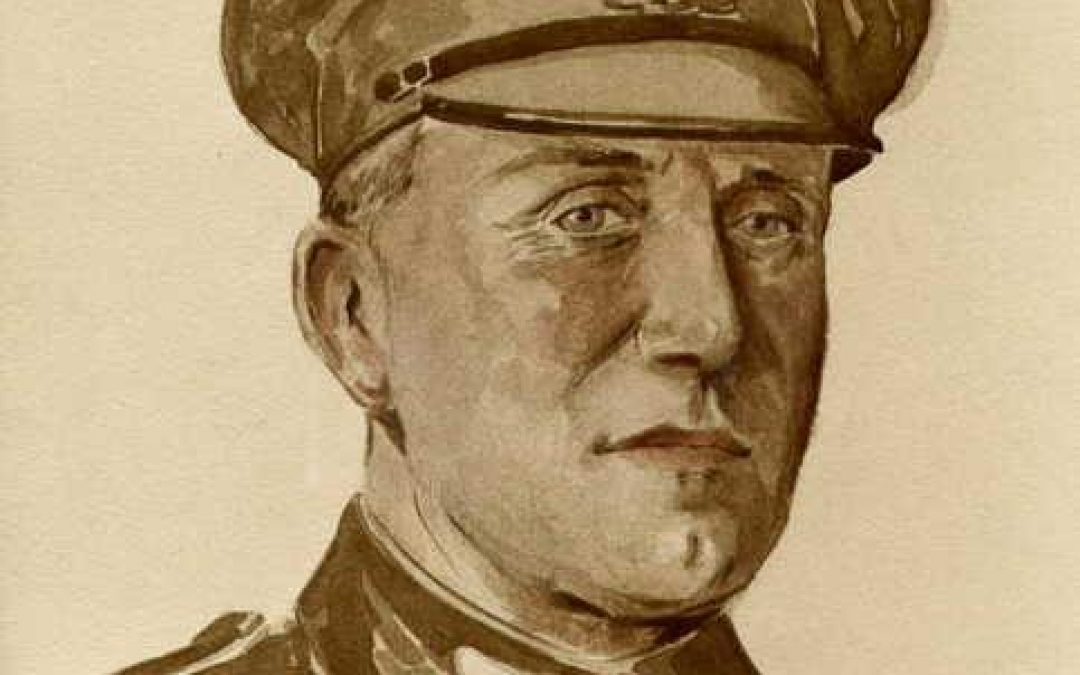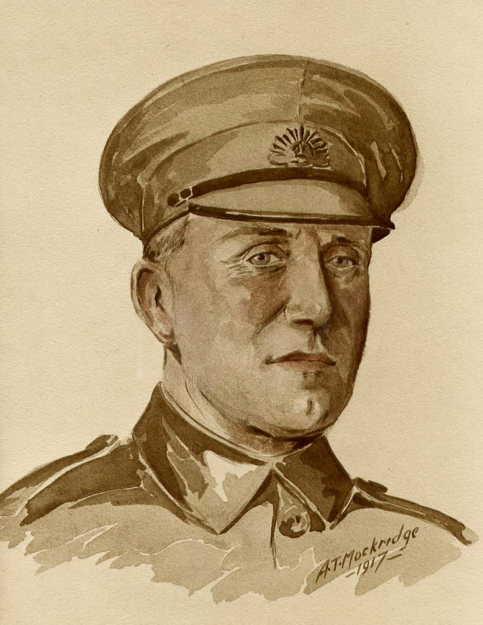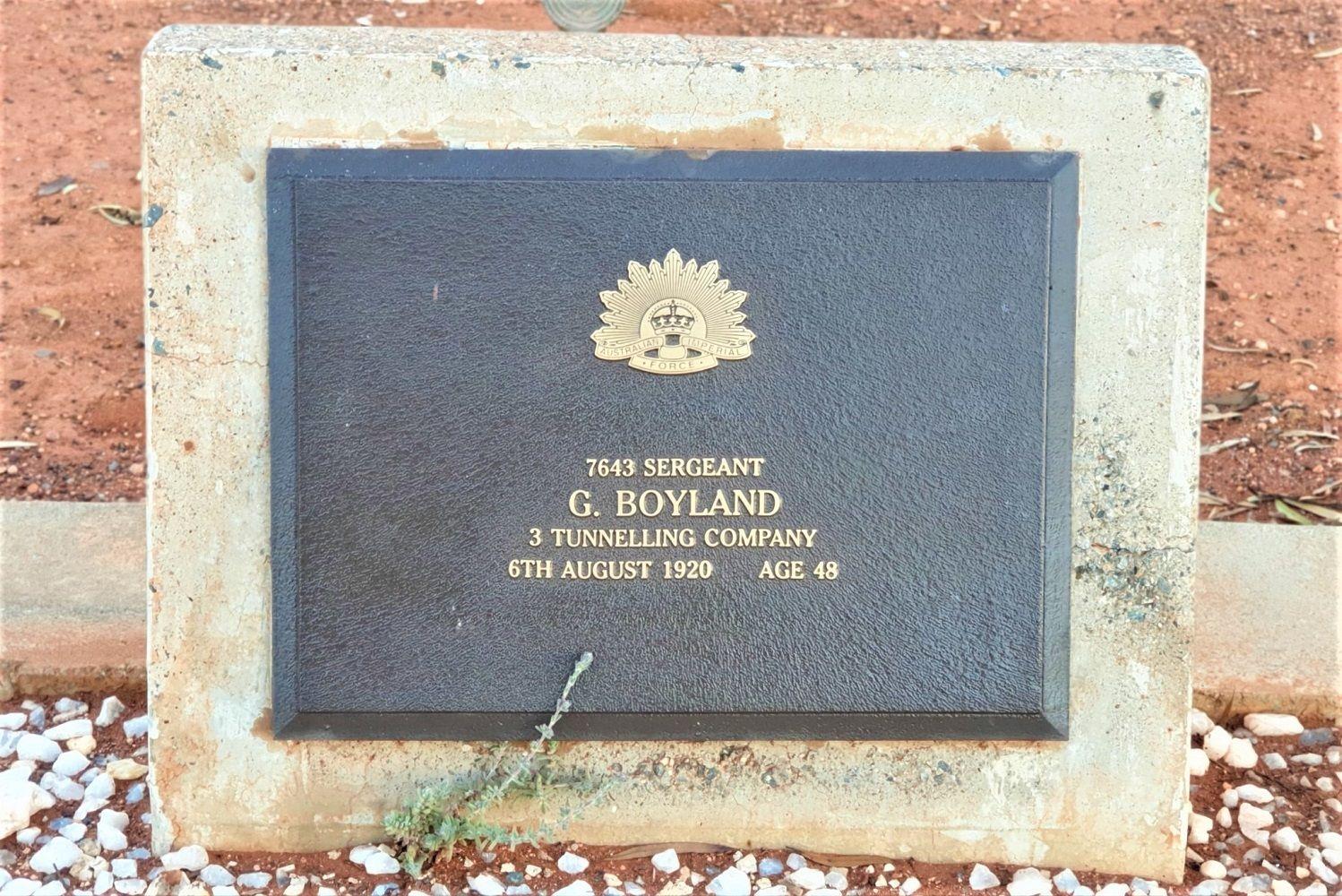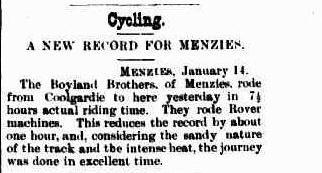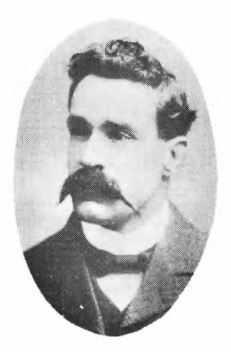Young men “turned to stone”.
George Boyland
George Boyland was born in Garden Gully, Bendigo, Victoria, on the 8th March 1872. The son of a miner, he and his brother and sister moved with their parents from Victoria to Queensland, and then around 1894 to Western Australia.
He seems to have travelled back and forth between WA and Victoria, marrying in Melbourne in 1898; two of his daughters from this marriage were born in Victoria, and his second daughter was born in WA. Sadly, his first daughter and his wife died in 1903 and 1904, respectively, in Kalgoorlie. In 1906, George was recorded as mining in Kalgoorlie with his father and brother, John. He married again in 1908.
At the age of 43, and by then a shift boss, George enlisted in the Australian Imperial Force on November 1915. He soon made Sergeant but barely made it to France before being returned to England with “severe chronic pneumono-konosis”. Miners’ complaint has had many names. It is caused by the inhalation of very fine silicate or quartz dust, causing inflammation in the lungs, often compounded by tuberculosis. In her book Turning Men into Stone, Criena Fitzgerald described men “exhausted by breathlessness and general debilitation with death often occurring from haemorrhaging of the lungs in a bout of prolonged coughing or suffocation”. George was discharged in June 1916 as “permanently unfit for any further military service” due to Phthisis (TB).
Sgt George Boyland. From the photo collection of John and Stella Boyland.
Amazingly, George re-enlisted at Kalgoorlie on the January 1917 and was accepted into the Mining Corp. One of the conditions that the medical examiners were required to assess recruits for was phthisis, and twice he was signed off as not having this disease.
He gained the rank of Sergeant with the 3rd Tunnellers and was posted to Europe in November.
The 3rd Australian Tunnelling Company was one of the tunnelling companies of the Royal Australian Engineers during World War I. The tunnelling units were occupied in offensive and defensive mining involving the placing and maintaining of mines under enemy lines, as well as other underground work such as the construction of deep dugouts for troop accommodation, underground chambers for signals and medical services, and trenches.
But deep into the French winter George was ill again, and repatriated to England in February 1918 due to age and debility. In July he returned to Fremantle diagnosed with phthisis. The Repatriation Department arranged treatment at the Wooroloo Sanatorium (near Northam) where his records noted that he’d lost three stone. George was discharged from the A.I.F. in August 1919 with “little hope of improvement”. He lived only one year after returning from the war.
George died, aged 48years, on the 6 August 1920 at his home in Lewis Street, Kalgoorlie. His Death Certificate states he died from Gas Poisoning (France), Pulmonary Tuberculosis and Cardiac Failure. He is buried in the Kalgoorlie Cemetery. The grave, unmarked for years, had an official memorial headstone erected on the plot in 1994 by the Department of Veteran’s Affairs, Office of Australian War Graves, at the request of the family.
Photo: Danelle Warnock. Kalgoorlie Cemetery
John “Jack” Boyland
Born 11 Sep 1874 in Bendigo, Victoria, Jack moved with his family to Queensland around 1881. He left school early and was a shearer in Queensland, taking part in the 1894 strike. From 1895 Jack was a miner, prospecting in W.A., an underground miner at Menzies and on the Murchison Goldfields, and from 1897 was mining and residing in Kalgoorlie.
Coolgardie Pioneer, Saturday 23 January 1897
Jack was a cycling champion of the goldfields and won the Coolgardie Austral Wheel Race in 1897 (later renamed the ‘Westral’, it continues today). He then worked in South Africa and visited England briefly.
In 1906, he, his father and brother, George, were mining in Kalgoorlie. He married in WA in 1906. Possibly because he had contracted Miner’s Phthisis, he was an enthusiastic unionist. In 1913 he represented the Federated Mining Employees’ Association at the Australian Labor Party Conference.
Jack volunteered for the AIF in 1914, but was rejected because of phthisis. Then Secretary of the Boulder branch of Coolgardie Miners Union and an executive member of the Boulder National Referenda League, he sought to serve by fervently advocating conscription on democratic grounds.
With the recent community 100th-anniversary commemorations for the World War 1 ANZACS, it is not widely appreciated the extent to which the campaign for conscription divided the community and split the Hughes ALP federal government. Prime Minister Hughes failed to force conscription through the parliament and twice it was rejected at referendum. There was an overwhelming vote for conscription in Western Australia and on the goldfields. Of all the Australian states, Western Australia sent more men per head of population to fight in WW1 and those who remained on the home front gave majority support for conscription.
It was in this political maelstrom that Jack operated. In 1916 he was Secretary of the Kalgoorlie and Boulder Federated Mining Union then Federal President of the Mining Union and president delegate to the Labor Council. He was a member of the ALP until 1916, when he switched to the National Party. In 1917 he was president of the National Labor Party, first formed on the goldfields but in August he was expelled as a conscriptionist and in November he resigned as secretary of the local union. He then became secretary of the Eastern Goldfields Mining and General Workers Union (industrial Wing of NLP).
In 1918, due to the strain on his weakening constitution, Jack Boyland resigned from office, but retained his union position. Between 1919-20 he was a patient at the Wooroloo Sanitorium, and later he opened a stall in the Kalgoorlie Municipal Markets.
Despite being labelled by some a traitor to the labour movement, Jack successfully contested the Kalgoorlie state electorate as an Independent Nationalist, defeating the sitting Labor candidate. He became MLA for Kalgoorlie from 12 March 1921 until his death.
Jack died aged 48 years on the 14 December 1922 at his home in Leederville, WA, and was buried in the Karrakatta Cemetery with his father. His Death Certificate gives the cause of death as Fibrosis of lungs (indefinite duration) and Heart Failure.
Acknowledgement: This article is based on the research of Priscilla Hill (wavmm.com.au) and Sue Boyland (ancestry.com.au).

